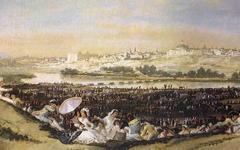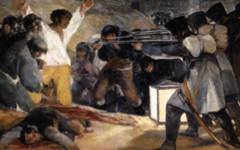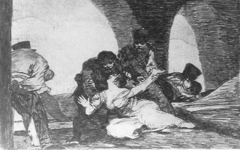Goya’s The Count of Cabarrús (1788)
Great portraitists have surely known that the identity of their sitters might sooner or later be forgotten. How relevant, then, is the sitter's biography to understanding the portrait? You need only think of the Mona Lisa, or Raphael's La Fornarina, to conclude: not very much. We know little, or nothing, about their subjects while the images remain masterpieces. Yet museums still promote a sitter's biography as though it is of primary importance. That is sad because an explanation of a great portrait's deeper significance would be far more fascinating. Goya's Portrait of The Count of Cabarrús is a typical example.

Goya, The Count of Cabarrús (1788) Oil on canvas. 210 x 127cm. Collection Banco de España.
Click image to enlarge.
The unconventional count, a renowned public speaker, was co-founder of Spain's first national bank, and the commissioned portrait was intended to dominate the boardroom. "This strong personality with radical ideas inspired Goya to paint" the portrait, remarked a scholar. Perhaps. But the count's figure, though posed like the orator he was, is clearly based on a court jester's, Velazquez's Pablo de Vallodolid. 1 He probably would not have been amused.
Click next thumbnail to continue

L: Goya, The Count of Cabarrús (1788)
R: Velazquez, Pablo de Vallodolid (c.1635) Prado, Madrid.
Click image to enlarge.
EPPH has described how Velazquez's jester (right) is an alter ego "painting" the picture.2 Both, then, are "artists" who point/"paint" with their brush-hand at the edge. This implies that their "actual" canvas is just out-of-view, the other arm bent to hold a "palette". Pausing, each turns to check his figure in the mirror which is the canvas and "self-portrait" we see. It is a mirror-canvas as in Las Meninas. Goya sees himself in the mirror of his mind as Velazquez: two masters united because, in true art's philosophy, their minds are all one.
Click next thumbnail to continue

Detail of the sword hilt in Goya's The Count of Cabarrús (R) with diagram (L).
Click image to enlarge.
The idea that Cabarrús "paints" while being painted by Goya is emphasized by the glittering hilt of his sword. The thick pigment of its grip and guard make it an almost 3-dimensional object emerging from the flat canvas. Swords in art, as explained elsewhere, commonly represent the artist's paintbrush. Its handle, therefore, emerges from the canvas so that the real Goya can "hold" it to continue work on portraying the count. To make such an esoteric matter clearer, the hilt is formed into a G-shape for Goya.
Click next thumbnail to continue

L: Goya, The Count of Cabarrús, detail
R: Goya, Self-portrait with Glasses, detail (1797-1800) Musèe Goya, Castres
Click image to enlarge.
This explains why Cabarrús loosely resembles Goya in a fusion of the sitter's features with the artist's. Besides, the fact that the portrait is still being "painted" is yet another lesson on time and the ever-present moment. Past and future do not exist; all life happens in the present.
In sum, other than for historians, the meaning behind major portraits would be a far more interesting story to tell museum visitors than the details of a boring biography.
More Works by Goya
Notes:
1. Goya: The Portraits (London: National Gallery) 2015, p. 59
2. Velazquez's Pablo de Vallodolid (1636-7)
Original Publication Date on EPPH: 19 Nov 2015. © Simon Abrahams. Articles on this site are the copyright of Simon Abrahams. To use copyrighted material in print or other media for purposes beyond 'fair use', you must obtain permission from the copyright owner. Websites may link to this page without permission (please do) but may not reproduce the material on their own site without crediting Simon Abrahams and EPPH.



